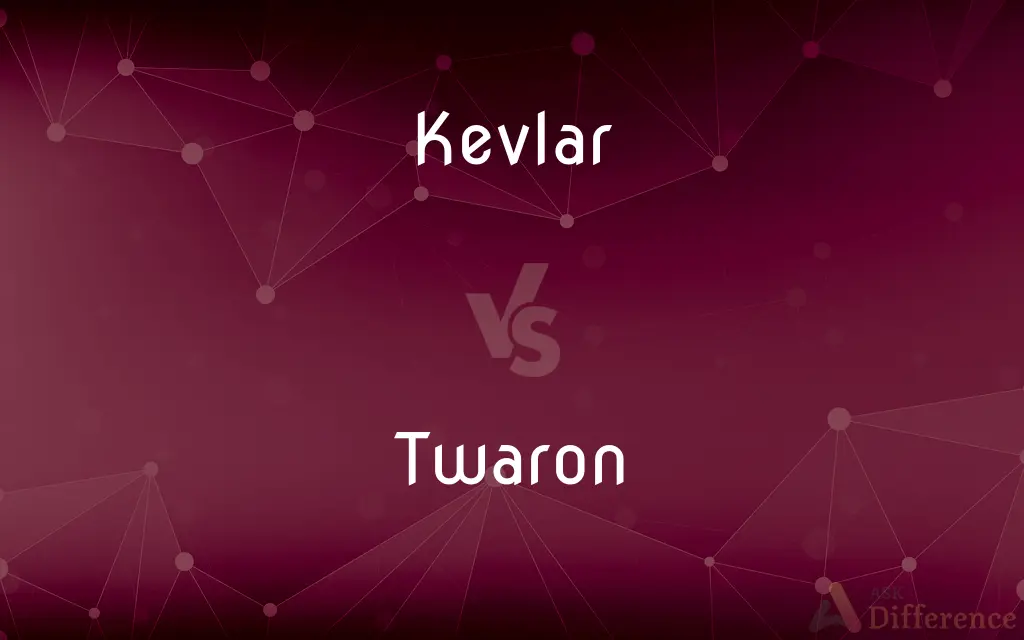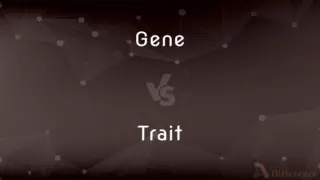Kevlar vs. Twaron — What's the Difference?
By Tayyaba Rehman — Updated on October 26, 2023
Both are synthetic aramid fibers, but Kevlar is a product of DuPont, while Twaron is manufactured by Teijin.

Difference Between Kevlar and Twaron
Table of Contents
ADVERTISEMENT
Key Differences
Kevlar and Twaron are both high-strength, heat-resistant aramid fibers utilized in various applications.
Kevlar, a product of the American company DuPont, has become synonymous with bulletproof vests due to its remarkable tensile strength. On the other hand, Twaron, which originates from the Dutch company Teijin, shares many properties with Kevlar and is likewise used in protective gear. Both fibers are exceptional in their resistance to heat, chemicals, and wear. This makes them prime candidates for applications in aerospace, military, and automotive industries.
Kevlar and Twaron, while comparable in function and characteristics, arise from distinct manufacturing processes and have nuanced differences in their properties.
As a result, they may be chosen for different applications based on specific requirements. Overall, while Kevlar might be the more globally recognized name, Twaron stands as a formidable counterpart in the realm of aramid fibers.
Comparison Chart
Manufacturer
DuPont
Teijin
ADVERTISEMENT
Origin
U.S.A
Netherlands
Typical Uses
Bulletproof vests, ropes, sails
Protective gear, tires, optical fiber cables
Recognition
More globally recognized
Less known but similarly effective
Molecular Structure
Slightly different due to manufacturing nuances
Slightly different from Kevlar
Compare with Definitions
Kevlar
A synthetic fiber of high tensile strength.
The bulletproof vest was reinforced with Kevlar for added protection.
Twaron
A competitor to Kevlar in many applications.
The company considered switching from Kevlar to Twaron for cost-saving measures.
Kevlar
A product of the DuPont company.
DuPont has made significant profits from its Kevlar patents.
Twaron
A product manufactured by Teijin.
Teijin has invested heavily in the research and development of Twaron.
Kevlar
Used in aerospace and automotive components.
The plane's brake pads were lined with Kevlar for enhanced durability.
Twaron
Utilized in protective equipment and industrial applications.
Twaron gloves offer protection against sharp objects.
Kevlar
Known for its protective qualities in body armor.
Soldiers trust Kevlar helmets for protection on the battlefield.
Twaron
A strong, synthetic aramid fiber.
Twaron is a preferred material in high-performance racing tires.
Kevlar
A heat-resistant material used in various industrial applications.
The firefighter's suit was embedded with Kevlar to resist flames.
Twaron
Resistant to heat and chemicals.
The chemical plant used Twaron-reinforced gear for its employees.
Kevlar
Kevlar (para-aramid) is a heat-resistant and strong synthetic fiber, related to other aramids such as Nomex and Technora. Developed by Stephanie Kwolek at DuPont in 1965, the high-strength material was first used commercially in the early 1970s as a replacement for steel in racing tires.
Twaron
Twaron (a brand name of Teijin Aramid) is a para-aramid. It is a heat-resistant and strong synthetic fibre developed in the early 1970s by the Dutch company Akzo Nobel's division Enka BV, later Akzo Industrial Fibers.
Kevlar
(uncountable) (Fabric, cordage, etc made of) aramid fiber, an exceptionally strong, light, man-made fibre used to strengthen cables and sheet materials, e.g. in stab-resistant vests.
Kevlar
A piece of personal protective equipment made from Kevlar, such as a helmet or a vest.
Common Curiosities
Are Kevlar and Twaron the same?
Both are aramid fibers, but they are products of different companies and have slight differences.
How are Kevlar and Twaron made?
Both are synthetic aramid fibers, but their manufacturing processes have nuances that result in slightly different properties.
Which is more popular, Kevlar or Twaron?
Kevlar is more globally recognized, but Twaron is similarly effective.
Which industries primarily use these fibers?
Aerospace, military, automotive, and protective gear industries are major users.
How long have Kevlar and Twaron been in use?
Kevlar was introduced in the 1960s, and Twaron in the 1970s.
Is one fiber stronger than the other?
Both fibers are known for high strength, but specific strength can vary based on manufacturing nuances.
Can Twaron replace Kevlar in bulletproof vests?
Yes, both fibers are used in protective gear, including bulletproof vests.
Are there specific applications exclusive to Kevlar?
While Kevlar has broader recognition, both fibers can be used in similar applications depending on specific needs.
Is Twaron more affordable than Kevlar?
Costs can vary based on factors like volume and location, but some industries consider Twaron for cost-saving measures.
Can these fibers be blended with other materials?
Yes, they're often blended or layered with other materials for enhanced properties.
What colors do Kevlar and Twaron come in?
Typically, they're yellowish or gold, but they can be dyed or coated for specific applications.
Are there other competitors to Kevlar and Twaron?
While Kevlar and Twaron are prominent, other aramid fibers and materials compete in specific applications.
Why are these fibers heat-resistant?
Their molecular structures make them resistant to high temperatures and degradation.
Are there any environmental concerns with Kevlar and Twaron?
Like many synthetic materials, proper disposal and recycling can be concerns.
How are these fibers processed into usable products?
They can be woven, layered, or blended with other materials to create various products.
Share Your Discovery

Previous Comparison
Pic vs. Pix
Next Comparison
Gene vs. TraitAuthor Spotlight
Written by
Tayyaba RehmanTayyaba Rehman is a distinguished writer, currently serving as a primary contributor to askdifference.com. As a researcher in semantics and etymology, Tayyaba's passion for the complexity of languages and their distinctions has found a perfect home on the platform. Tayyaba delves into the intricacies of language, distinguishing between commonly confused words and phrases, thereby providing clarity for readers worldwide.














































